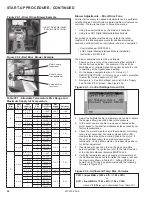
32
MCP15-500.9
START-UP PROCEDURE - CONTINUED
THE FOLLOWING SECTION APPLIES ONLY TO B- AND D-CABINET
SIZED UNITS WITH OPTIONAL ENERGY RECOVERY EXHAUST
(MODEL NOMENCLATURE DIGIT 6=B OR D, DIGIT 7=B OR E).
IF THE UNIT DOES NOT HAVE THIS OPTION, SKIP TO PAGE 34.
j
REVIEW
BEFORE
PROCEEDING
1. Turn off power to the unit at the disconnect switch. If
equipped with gas heating option, turn all hand gas valves
to the “OFF” position.
Note:
The dead front disconnect switch, if included, is
factory installed in the controls/compressor compartment
section (refer to the figures on pages 36 through 39). The
disconnect switch is designed so that it must be turned
“OFF” before entry to the compartment can be obtained.
When in the “OFF” position, power is disconnected to all
unit wiring electrically following the switch (see
WARNING).
2. For units equipped for dual power supply sources, both
sources of power must be disconnected to prevent
electrical shock and equipment damage.
3. Open the power compartment, controls compartment, and
blower access doors. Refer to Figure 33.1 for location of
doors and internal components.
4. Check that the supply voltage matches the unit supply
voltage listed on the Unit Serial Plate. Verify that all
wiring is secure and properly protected. Trace circuits to
insure that the unit has been wired according to the wiring
diagram.
5. Check that fuses or circuit breakers are in place and sized
correctly.
6. Check to see that there are no obstructions to the intake
and discharge of the unit.
IMPORTANT
1. On units with the electric preheat option, to prevent
premature heat exchanger failure, check to be sure the
blower has been set to deliver the proper airflow for the
application. Refer to page 19 for Blower Adjustments.
2. The exhaust fan is not designed for high temperature
or smoke control exhaust applications. Exhaust air
temperature must not exceed 104°F. Operating the
exhaust fan above 104°F will result in failure of the
exhaust fan.
WARNING
WARNING
1. The power supply wiring for the Energy Recovery
Section comes from a single point power connection
on the unit. Disconnect power supply at model MPR
before making wiring connections to prevent electrical
shock and equipment damage.
2. For units equipped for dual power supply sources, both
sources of power must be disconnected to prevent
electrical shock and equipment damage.
j
If the unit is a C-cabinet size and has energy recovery exhaust, refer to the latest revision of literature #MCP15-520 for the
Start-Up Procedure for the Model ERM Energy Recovery Module.
7. Check the belt tension and sheave alignment for the
exhaust blower.
8. Most motors are permanently lubricated for long life and
are identified as such on the motor nameplate. Most blower
bearings are permanently lubricated as well, except for
pillow block bearings or those identified with grease fittings.
For motors or blower bearings that are not permanently
lubricated, lubricate according to the manufacturer’s
instructions.
9. Check to make sure that all filters are in place and that
they are installed properly according to direction of air flow.
10. Perform a visual inspection of the unit to make sure no
damage has occurred during installation.
11. Turn on power to the unit at the disconnect switch.
Note:
The unit includes a door switch installed inside the
exhaust blower section access door. When the
door is opened, the switch interrupts power to a
microprocessor controller input and the exhaust
blower motor is de-energized.
12. Check the Modine Control System controller and exhaust
fan blower motor for electrical operation. If this does not
function, recheck the wiring diagram. Check to insure that
none of the Control Options have tripped.
13. Check to make sure that the economizer wheel bypass
damper (if equipped) opens properly without binding.
14. Check the blower wheel for proper direction of rotation
when compared to the air flow direction arrow on the
blower housing. Blower wheel rotation, not air movement,
must be checked as insufficient air will be delivered with
the blower wheel running backwards.
15. Check the blower speed (RPM). Refer to Blower
Adjustments for modification.
16. Check the motor speed (RPM).
17. Check the motor voltage. Check to make sure all phases
are in balance.
18. Check the motor amp draw to make sure it does not
exceed the motor nameplate rating. Check all phases to
insure system is balanced.
19. Check that the energy recovery wheel rotates in the
direction of the arrow without interference noise (scraping,
brushing, banging etc.). The wheel is factory set to rotate at
approximately 40 RPM to maximize latent heat transfer.
20. Check that the belt tracks near the middle of the wheel rim,
not against the rim support, and that the belt is not flipped.
21. Check the energy recovery wheel voltage and amp draw to
make sure it does not exceed the motor nameplate rating.
Energy Recovery Exhaust Option
Содержание MPR Series
Страница 17: ...17 MCP15 500 9 PAGE INTENTIONALLY LEFT BLANK ...
Страница 67: ...67 MCP15 500 9 PAGE INTENTIONALLY LEFT BLANK ...
















































